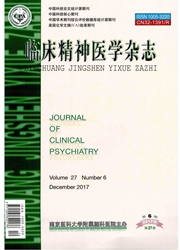

 中文摘要:
中文摘要:
目的:探讨伴轻度抑郁症状的双相障碍患者执行功能、注意功能与健康对照者的差异。方法:40例伴轻度抑郁症状的双相障碍患者(研究组)和40名年龄、性别、受教育年限与研究组匹配的健康者(健康对照组)均采用威斯康星卡片分类测验(WCST)及持续操作测验(CPT)测试两组执行功能和注意功能。结果:两组WCST测试成绩除完成第1个分类所需应答数、非持续性错误数差异无统计学意义(P〉0.05)外,完成分类数、总应答数、正确应答数、错误应答数、持续性错误数、持续性错误率组间差异有统计学意义(t=-6.10-5.96,P均=0.000);CPT测验中正确数研究组明显低于健康对照组(t=-3.87,P=0.000);错误数明显高于健康对照组(t=5.21,P=0.000)。结论:伴轻度抑郁症状的双相障碍患者存在执行功能损害和注意功能损害。
 英文摘要:
英文摘要:
Objective:To explore the differences of the executive function and attention function between patients of bipolar disorder with mild depressive symptoms and healthy controls. Method:Forty patients of bipolar disorder with mild depressive symptoms(study group)and age,sex and education year matched forty healthy controls(healthy control group)were entolled. The Wisconsin card sorting test(WCST)and the continu-ous performance test(CPT)were used to assess and compared executive function and attention function between two groups,respectively. Results:For WCST,there were no statistically differences in trials to compete first category and nonperseverative errors(P 〉 0. 05),but statistically significant differences in number of categories completed,trials administered,total correct responses,total errors,perseverative errors,and persistent error rate be-tween two groups(t = -6. 10-5. 96,P =0. 000). In CPT test,the correct number in study group was significantly lower than that in the healthy control group(t = - 3. 87,P = 0. 000),while the error number in study group was significantly higher than that in the healthy control group(t = 5. 21,P = 0. 000). Conclusion:The patients of bipolar disorder with mild depressive symptoms had impaired executive function and attention function.
 同期刊论文项目
同期刊论文项目
 同项目期刊论文
同项目期刊论文
 期刊信息
期刊信息
